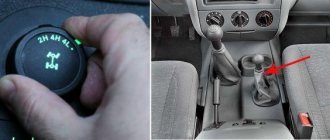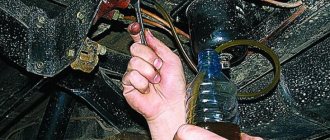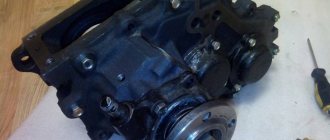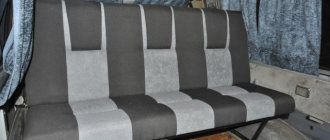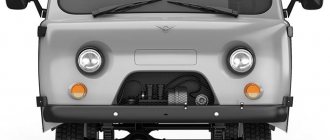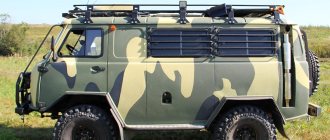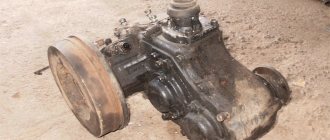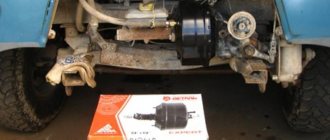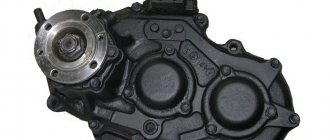The vehicles produced at the plant in Ulyanovsk are classified as off-road vehicles; it is no coincidence that the package includes a UAZ transfer case. The mechanism is designed to distribute the torsional impulse of the motor to the wheels. The design increases the number of transmission gears and torque when moving off-road.
Initially, UAZ vehicles, including the Bukhanka, were developed for the needs of the army. That's why the transmission is simple, unpretentious and requires minimal maintenance. Thanks to these qualities, the car appealed to lovers of hunting, fishing, and tourism. In addition, the transport is suitable for transporting goods in the absence of roads.
Transfer case UAZ-452 “Loaf”:
The device of the UAZ “Bukhanka” transfer case
The UAZ Bukhanka transfer case is a two-stage design without a differential between the axles. The mechanism is also equipped with a neutral message and switchable front wheels. The components are placed in a tray made of cast iron and equipped with a plug. The pallet is attached to the back of the box through the holes of the plates. In addition, the components of the handbrake are also attached here. The main and transition shafts of the box, the drives of the front and rear wheels, are secured by bearings. Between the supports that facilitate the rotation of the shaft, a gear is placed that drives the speed measuring device. The top of the box has an inspection hatch protected by a shutter.
Dymos transfer case for UAZ (finishing):
The control contains two rods with forks attached to a plug. The fork-shaped rods work in tandem with the drive gear and the activation gear for the front pair of wheels. Two control rods are connected to the forks by means of movable pins. There is also a blocking sphere that prevents the activation of low gear when the front wheels are not working.
By activating direct transmission, the UAZ Bukhanka transfer case acts in a similar way so that the main gear moves into the slot of the gear shaft of the rear pair of wheels, transporting the impulse directly. Activating the low gear shifts the main gear so that the impulse is transported to the intermediate shaft and to the gears that drive the axle. Activation of the low stage is only possible after the machine has come to a complete stop.
UAZ Bukhanka transfer case diagram:
Location of controls on UAZ vehicles
- steering wheel. The steering wheel of UAZ-31512, UAZ-3153 and the UAZ-3741 family vehicles has a central horn button. The steering wheel of UAZ-31514 and UAZ-31519 cars is equipped with an energy-intensive pad and has two horn buttons located in the wheel spokes.
- rear view mirror (internal). Adjustable by turning around the articulated head.
- instrument panel (see Fig. 1.17-1.21).
- sun visors.
- windshield blower pipes.
- passenger handrail.
- lantern (plafond) lighting.
- battery ground switch. Switching the “mass” on and off is done by turning the knob 90°.
- front drive axle lever. It has two positions: front - the axle is on, rear - the axle is off (Fig. 1.14). Before engaging the front axle, engage the front wheels. Turn on the axle while the vehicle is moving.
- heater
- transfer case control lever. It has three positions: forward - direct gear is engaged, middle - neutral, rear - downshift is engaged (Fig. 1.15). Before downshifting, engage the front axle. Engage the downshift with the clutch disengaged and only when the car is completely stopped.
- gear shift lever. The switching diagram is shown on the handle and in Fig. 1.16 Switch gears by smoothly pressing the lever without jerking. If you cannot engage the required gear before moving off, lightly release the clutch pedal, and then disengage the clutch a second time and engage the gear. When switching from a higher gear to a lower one, it is recommended to disengage the clutch twice and briefly press the throttle pedal. Engage reverse gear only after the vehicle has come to a complete stop. When you engage reverse, the reversing light turns on.
- parking brake lever. To turn the lever on, move it back; to turn it off, press the button at the end of the lever and move the lever forward until it stops. When the parking brake is engaged, the red warning lamp on the instrument panel lights up.
- handle for driving the hatch cover for ventilation and heating of the body.
- handle of the fuel tank switching valve. The handle is turned forward - the valve is closed, turned to the left - the left tank is on, turned to the right - the right tank is on. The valve is not installed on vehicles with one fuel tank.
- carburetor throttle pedal.
- service brake pedal. Brake the car smoothly, gradually increasing pressure on the pedal. When braking, do not let the wheels slide, as in this case the braking effect is significantly reduced (compared to rolling braking) and tire wear increases. In addition, strong and sudden braking on a slippery road can cause the car to skid.
- clutch pedal. When changing gears and starting from a stop, the clutch pedal should be pressed quickly and fully, and released smoothly. Depressing the pedal slowly or incompletely causes the clutch to slip, making it difficult to shift gears and causing increased wear on the clutch plate. When the pedal is suddenly released (especially when starting from a standstill), the load on the transmission increases, which can lead to deformation of the clutch driven disc and other transmission parts. When driving the car, do not keep your foot on the clutch pedal, as this leads to partial disengagement of the clutch and the disc slipping.
- foot switch for headlights. By pressing the button, with the headlights on, the low beam or high beam headlights are turned on. Not installed on vehicles with multifunctional left-hand stalks.
- portable lamp socket.
- radiator shutter control handle. Under certain operating modes and climatic conditions, in order to maintain the temperature of the engine coolant within 70-80 ° C, it is necessary to regulate the amount of air cooling the radiator using blinds. When the handle is pulled, the blinds close.
- rear view mirror (external).
- turn signal switch handle. The handle automatically returns to the neutral position when the steering wheel is turned in the opposite direction (when the car enters a straight line). Some cars are equipped with multifunctional steering column switches (see Fig. 1.24).
- carburetor throttle control handle. The extended handle is fixed by turning 90° in any direction.
- carburetor choke control knob. The extended handle is fixed by turning 90° in any direction.
Checking the transfer case
The advantage of the unit that distributes the torque impulse is that the device requires minimal intervention and maintenance. Manipulations consist of monitoring the level and changing the lubricant, inspecting connections for damage. Before working with the box, the product is cleaned. This helps detect hidden cracks and leaks. If such symptoms are detected, they find out what the cause of the phenomenon is. Faulty parts are replaced, as a rule, these are sealing elements and oil seals.
After cleaning and visually inspecting the surface of the transfer case, check the lubricant level in the product. If there is not enough liquid, the substance is added. At the same time, check the lubricant in the gearbox; the value corresponds to the lower edge of the filling hole. If the fluid level in the transfer case is low, but is high in the gearbox, topping up is not necessary, since the total amount of the substance has not changed.
A detailed inspection of the box involves dismantling the product. After washing and air drying, the unit is inspected. The pallet and plugs are checked for cracks and chips. Oil seals and seals are replaced with new ones.
Changing the oil in the UAZ transfer case:
They check that the condition of the working parts on the shafts and splines corresponds to the standard, so that the gear teeth are not worn or chipped. Even if the damage is small, the product must be replaced. Attention is paid to the bearings; abrasions on the ring tracks are not acceptable. They also check separators, spheres, rollers, etc. Gaps, fragments, knocking, uneven movement are a signal to change the product.
The rods and forks become jammed and deformed, the elasticity of the spring elements is lost, and then the products are replaced. In addition, you should pay close attention to switching when the transfer case levers of the UAZ Bukhanka stick and jam. The coupling teeth are checked for damage. The weak link of the differential is the satellite. Small defects force the product to be polished, or in the worst case, replaced.
How does a UAZ transfer case work?
The UAZ “Bukhanka” transfer case is controlled via a lever in the cabin. It is located between the driver and passenger seats and takes 2 or 3 positions. Some models of boxes provide the output of 2 levers (they are called double-lever).
How to turn on the transfer case on the UAZ “Bukhanka” (mechanical):
- the drive shaft receives torque;
- rotation is transmitted from the primary shaft to the secondary shaft through gears (this happens immediately, because 1 gear is motionlessly locked with the primary shaft on one side and has a contact zone with the secondary on the other);
- The movable gear of the secondary shaft transmits the resulting force to the vehicle axle.
The new generation UAZ transfer case (two-stage) is controlled a little differently. Unlike the old box, this mechanism does not have a lever (changing the position of which requires considerable effort), but a switch. To ensure that its activation is not accidental, the manufacturer has provided special protection through an established launch algorithm. So, to redistribute the load in a two-stage transfer case, you need to:
- set the gearbox lever to “neutral”;
- change the position of the switch (to the right all the way);
- disengage the clutch until the indicator light appears on the panel;
- engage the clutch.
If these steps are followed, the load will be transferred to the front axle.
Causes and troubleshooting
The design of the UAZ gearbox is reliable, trouble-free and durable. However, problems with equipment occur due to errors in use and violation of established regulations.
| Source and symptoms | What to do |
| Exceeding the permissible hum level of a working device | |
| Erasing the gear teeth of the box. | Replace worn out box items. |
| Weak fastening of the transfer case to the box, or reduced fixation of the bearing caps. | Tighten the fasteners, if the symptom recurs, dismantle the product and eliminate the defect. |
| Bearings are worn out. | Replace erased items. |
| Saturation of the working fluid with wear products from the box. | Remove the pan, wash it, change the oil. |
| Incorrect oil used, low fluid filling level. | Change the working fluid, set the desired level. |
| Carrying out repairs to replace gears, without selecting a product to minimize noise. | Check the gears for noise and replace them with the required ones. |
| Switching steps is difficult | |
| Different wheel wear. | Replace with wheels with the same tread and equalize the internal pressure. |
| The joints of the longitudinal projections of the main and the mediator shaft are jammed. | Sand the areas with burrs; if that doesn’t help, change the elements. |
| The drive gear has damage on the teeth of the small ring. The shift fork rod is bent. | Sand the damaged areas, straighten the rod, if that doesn’t help, change the element. |
| The switch rods are stuck on the axle. | Separate the parts, clean the axles and pipes, coat with lubricant, and connect the product again. |
| Spontaneous speed shutdown | |
| Erasing the teeth of the gears of the box. | Replace worn out box items. |
| The box bearings are worn out. | Replace worn box elements. |
| A large gap in the articulation of the shaft and gear. | Select the gear according to the size of the longitudinal protrusions. |
| The transmission is unable to engage because the mechanism is bent or there is damage to the gears and cylinders. | Correct bends, sand damage, or replace parts. |
| Poor functioning of the locking mechanism, loss of elasticity of the spring mechanism, abrasion. | Replace erased items. |
| Leakage of working fluid | |
| Violation of the integrity of the sealing elements of the pan, bearing caps, and the transfer case’s articulation with the gearbox. | Replace sealing elements. |
| Weak fastening of the cover, bearing, pan, joints. | Tighten connections. |
| Violation of the integrity of the shaft seals. | Replace the damaged element. |
| Violation of the integrity of the tray or lid. | Replace the damaged element. |
| The plugs of the switching rods, switching rods, and the plugs of the front bearing of the middle shaft fall out or are broken. | Change the plugs. |
| Bearings are damaged | |
| No, or a small amount of lubricant. | Change or add fluid. |
| Demolition of cages and bearing rings due to abrasive. | Change the elements, dismantle and wash the pan, change the working fluid. |
| Excessive shaft bearing friction. | Disconnect the element, clean the product, and coat it with lubricant before reassembling. |
Repair of UAZ Bukhanka transfer case
Serious repairs to the UAZ transfer case are rarely performed. As a rule, to restore normal operation, adjusting the product and lubricating problem areas is enough. If repairs cannot be avoided, then the operation to return the box to its former functionality is done in strict order.
- Dismantling the transfer case;
- Disassembling the transfer case;
- Fault detection;
- Troubleshooting (replacement, restoration of parts);
- Transfer case assembly;
- Installing the transfer case in place;
- Functionality check and configuration.
Before carrying out work, select the necessary tools; for this, find out the type and type of transfer case. Functionally, repair is the replacement of damaged parts with new ones, for this reason more attention is paid to the rejection stage.
- Oil seals (changed during disassembly, regardless of the degree of wear);
- Gears (parts cannot be repaired due to the loads they experience);
- Forks and splines (elements affect the quality of work and safety);
- Bearings;
- Protective casing (if cracks or chips are detected, the part is replaced).
UAZ transfer case control mechanism:
Repair
It is extremely difficult to check and restore new transfer cases in “garage” conditions. With such a problem, it is better to contact the service. But repairing the transfer case of the UAZ-469 and its successor, the Hunter, with some theoretical training and some practical experience, can be done with your own hands.
Disassembling and subsequent reassembling of the UAZ transfer case is a simple, but labor-intensive process. What to do:
- put the car on a pit (in specialized workshops a lift is used for this purpose);
- secure the car by placing chocks under the wheels;
- shift the gear to neutral;
- move the parking brake lever down;
- drain the oil from the transfer case (unscrew the plug, place a container, wait until the leak stops);
- unscrew the bolts securing the drive shafts and remove them (shafts);
- remove the lever;
- disconnect the transfer case sensors;
- remove the parking brake cable;
- unscrew all the fastening bolts before removing the transfer case on the UAZ “Loaf” and remove it from the gearbox.
All manipulations will be easier to carry out if you first remove the entire parking brake assembly. And assembly will be much easier if, before starting work, you mark (or photograph) the position of the flanges relative to each other (the connection of the cardan shafts and the box itself).
After removing the transfer case, you need to disassemble it, diagnose the parts (find the fault) and replace it, if possible. All consumables (seals, oil, seals) are replaced in any case. The last stage of repair is assembly.
UAZ Bukhanka transfer case control
The UAZ Bukhanka transfer case is controlled remotely from the driver’s cab. The levers used to manipulate the car are located on the right side of the user. The upper rod activates and deactivates the front pair of wheels of the car, has two positions: top (the bridge is activated), bottom (the bridge is deactivated).
Position of the transfer case levers of the UAZ Bukhanka:
The location of the transfer case levers on the UAZ Bukhanka is possible in three options. First, the main gear is activated, middle (zero), the main shaft does not rotate, second, low gear is activated.
In order to avoid damage to the transfer case if the gear is incorrectly activated, a locking device is provided. The product is fixed in the cover of the gear change rods. Thanks to the fuse, the low gear is activated after the front pair of wheels is activated. Meanwhile, the front pair of wheels is not activated when a downshift is engaged. A solution has been implemented with a ball acting as a lock. The sphere in the cover prevents the rods from moving and deactivates the front pair of wheels until the rods are put into downshift. The lock prevents the driveshaft and rear pair of wheels from being overloaded.
There are single-lever control elements, one rod alternately activates: the front pair of wheels, zero, then low stage.
The UAZ-452 was originally created for the Soviet armed forces as a medical service vehicle, where it was therefore dubbed the “tablet” (the civilian nickname is “loaf”).
Therefore, the design of the mechanisms, including the transfer case, is simplified as much as possible.
During operation, the entire transmission system is unpretentious, which is confirmed by half a century of practice. The only recommendation from the manufacturer is to periodically check the oil level and check the fasteners.
In addition, if necessary, the front linkages should be adjusted and the lever axles should be lubricated on a preventive basis. This mechanical unit, including bearings, does not require any further maintenance or adjustment.
What functions does the UAZ transfer case perform?
The UAZ transfer case, also known as the transfer case, is a unit that is responsible for the “distribution” (distribution) of torque to the front and rear axles. Like all all-wheel drive SUVs, cars of this brand by default have 1 drive axle - rear. But they leave the opportunity to distribute the force to the front axle. The distribution box is responsible for this.
It performs 3 main functions:
- torque distribution between the front and rear axles;
- inclusion of a lower gear range, which allows you to increase torque to overcome a serious obstacle (lower gear is not available everywhere);
- locking the center differential.
In simple words, this means that when switching the transfer case to an UAZ, you can achieve improved cross-country ability, optimal controllability and maneuverability. Some transfer case models (including tuned ones) provide not only switching to the front drive shaft (or distributing the load to both axles), but also completely disabling the front axle.
Placement and appearance
The transfer case on all UAZ models, including Hunter and Patriot, and the good old Bukhanka (UAZ-452 transfer case), is installed in the gearbox block. It is connected to the chassis by 2 drive shafts (leading to the front and rear axles, respectively). Center the transfer case on the outer part of the 2-row secondary shaft bearing.
The unit is a mechanical box (cast iron or aluminum), through the cover of which 1 or 2 control levers are led into the passenger compartment (in the gearbox). In new models, the levers are replaced by a flat round switch.
We invite you to watch an interesting video about the UAZ “Hunter” with a reduction of 3.36 in the transfer case:
Features of the box
The UAZ-452 transfer case is the heart of the car’s transmission. It transmits dynamic force to the front and rear axles and has 2 operating modes: direct and reduction (with a gear ratio of 1.94).
The latter helps create more efficient traction when overcoming off-road conditions and terrain folds.
During assembly, the operating gears of the transfer case are mounted taking into account the noise emitted during rotation. When a worn gear is replaced with a new one during operation, an increased level of noise often occurs in the gearbox, which is not dangerous and usually goes away over time.
Transfer case on a UAZ car - features and principle of operation
Administrator SpetsTuningUAZ
The cars of the Ulyanovsk Automobile Plant are valued by their owners for their reliability and cross-country ability, the ability to overcome almost any road conditions, and for comfortable and safe off-road driving, motorists should be well aware of the structure and operating features of the transfer case on a UAZ car.
Why do you need a transfer case on SUVs?
The transfer case of a UAZ and any other SUV is needed to provide the vehicle with the ability to effectively drive off-road, rough terrain and on poor country roads and dirt roads.
With the help of the RK, the driver can reduce wheel torque when overcoming particularly difficult sections. Such actions can significantly reduce the level of slippage even in the most difficult conditions, including when stuck in a wetland.
The UAZ transfer case is a functional product, the value of which is clear to almost all car owners. This item:
- increases cross-country ability;
- improves vehicle handling;
- increases maneuverability;
- makes the car universal, capable of performing well on any trip.
Typically, an SUV drives on the rear axle (it is the drive axle), and no torque is transmitted from the engine to the front. However, if the driver has to overcome a difficult section, he can make both axles driven.
The design of the UAZ transfer case is such that it can only be used when driving on difficult roads; you won’t be able to drive on asphalt on two bridges if you don’t want to pay for the repair of the transfer case.
How does the device work?
In principle, the operation of the transfer case is quite simple. In general, it is only needed to connect/disconnect vehicle axles. By means of a center differential, it is possible to change the torque and transmit it to the front and rear axles with uniform or divided force to different wheels.
The operation of the UAZ “Bukhanka” transfer case can be schematically depicted as follows:
- Rotation comes from the gearbox to the drive shaft, which is transmitted through gears to the intermediate shaft. In the transfer case design, one of the intermediate shaft gears is locked with the drive shaft, so the rotational effect is transmitted immediately.
- The intermediate shaft has a movable gear that transmits rotation to the vehicle axle through a control mechanism.
- There is also a center differential, which is necessary to improve transmission and vary torque. It is used to relieve shifting load and smooth rotation transition.
Features of the transfer case on a UAZ
The distribution box for the UAZ “Bukhanka” and other models from the Ulyanovsk plant includes several elements. It consists of:
- drive shaft;
- differential;
- differential locks;
- rear/front axle drives;
- gear and reduction gears;
To control the transfer case, special levers are placed inside the car, allowing you to control the axles without going outside: turn the front axle on or off, turn both on at the same time, etc.
An important design element is the crankcase with a cover, which is fixed to the rear wall of the gearbox. For centering, the device uses a ball bearing of the UAZ transfer case.
The crankcase and cover are connected to each other with pins and small bolts. The handbrake mechanism is located behind the transfer case. The bearings contain: drive, intermediate shafts and shafts necessary for simultaneous drive of both axles.
Which transfer case is better for a UAZ?
Different UAZs (models and years of production) are equipped with different transfer cases. At the same time, motorists often argue which is better: a helical transfer case on an UAZ or a straight-cut, single-lever or double-lever?
The Ulyanovsk plant predominantly uses helical transfer gears, which, due to the larger number of teeth in engagement, are capable of transmitting greater torque. As for the spur tooth, it experiences only radial loads, without axial ones, which in theory should provide it with a longer shelf life.
However, in practice they are both good.
Transfer case maintenance
With constant use of the vehicle, the transfer case of the UAZ “Patriot” and any other model requires careful maintenance.
The standard part care process includes:
- visual inspection for the presence of lubricant leaks in places where rubber seals and gaskets are located;
- checking the fasteners that attach the gearbox to the gearbox and tightening the propeller shaft bolts;
- Changing the oil in the UAZ transfer case.
Car maintenance requires simultaneously changing the oil in the gearbox and transfer case of the UAZ Patriot. The frequency of replacement is determined independently, taking into account the manufacturer’s recommendations. Regardless of which transfer case is installed on the UAZ, the Ulyanovsk Automobile Plant recommends changing the oil every 35-40 thousand kilometers.
When regularly operating a vehicle in off-road conditions, the oil must be changed more often, since the transfer case and the entire transmission of such a vehicle are subject to increased loads.
Without careful maintenance and care, the transfer case may fail, after which the driver will have to replace the UAZ RK with a new one.
Controlling the transfer case on a UAZ car
For convenient and efficient control of the transfer case, the cabin has levers located to the right of the driver:
- Upper. Used to turn the drive axle on and off. It works only in two positions: in the upper position it turns the bridge on, in the lower position it turns it off.
- Lower. Used in design to change gears. Can be set to 1 of 3 different positions: forward, neutral and low.
When operating the transfer case, you need to take into account that the front axle is used only for operating the machine in difficult off-road conditions, if you need to overcome mud, snow or sand. It cannot be used on a good road, otherwise you will soon need to buy a new one and install a UAZ transfer case.
If for some reason the device fails, you can buy an inexpensive RK assembly or spare parts for the UAZ transfer case in our store.
Contact us, we will help you solve any problem with your car.
Source: https://spectuninguaz.ru/news/ustroystvo-razdatki-na-avtomobile-uaz/
Transfer case of UAZ-452 car
Device
The transfer case is designed to transmit torque to the front and rear axles and has two gears: direct with a gear ratio of 1.00 and a reduction gear with a gear ratio of 1.94.
Unit repair and maintenance
Signals for repairs can be:
- Oil leak.
- Increased noise and vibration.
- Difficulty switching from one position to another.
- Spontaneous loss of the switched on operating mode.
Although often, to fix problems, it is enough to just adjust the fasteners or lubricate problem areas and points. If this does not help, the car must be driven into an inspection pit or overpass, after which technological operations must be carried out in strict sequence.
Repair stages:
- dismantling and disassembling the box;
- failure detection;
- elimination of the causes of malfunctions (replacement or restoration of parts);
- assembly, installation in a regular place, adjustment.
Transfer case control
Both levers are located in the cabin on the right side of the driver. The top one is designed for remote control of the front axle and is fixed in 2 positions - rear (when the drive is turned off) and front (when the drive is on).
The “loaf” front axle is used only when driving a car in difficult conditions. “Turn off the front axle when driving on dry, hard roads!” is attached to the “dashboard” in front of the levers
The lower one drives the range multiplier (which in the auto industry is also called a divider). The fact is that in a UAZ, as in any all-terrain vehicle or off-road vehicle, gear shifting is provided not only in the gearbox, but also in the transfer case.
